Calling All Citizen Scientists!
All you need is a smartphone and a love of nature to make valuable contributions to conservation science.
At 7 a.m., when I rendezvoused with Dan MacNeal on a lonely dirt road in Amaranth, the temperature was a crisp 8 C. But the early July morning was sun-drenched and full of promise. Dan was standing atop a bridge on the road, his binoculars tracking a flurry of cliff swallows darting and gliding over a farm field and a languid stream. The flock of about 200 birds would regularly coalesce and dive under the bridge and then back out again. We clambered down to the stream bank and found scores of exquisitely hewn mud nests plastered against the concrete bridge supports. The adult swallows that entered the nests were likely brooding either eggs or recently hatched nestlings.
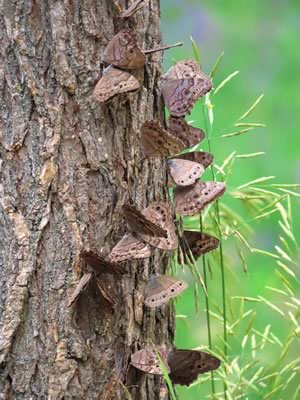
Northern pearly eyes. Photo by Don Scallen.
Finding this cliff swallow colony was propitious, a great start to a morning of birding in one of Dan MacNeal’s two observation squares for Ontario’s Breeding Bird Atlas.
Dan is a regional co-ordinator for the atlas, an impressive conservation project administered by Ontario Nature in partnership with Birds Canada, Environment and Climate Change Canada, Ontario Field Ornithologists, and Ontario’s Ministry of Northern Development, Mines, Natural Resources and Forestry – and made possible by the survey efforts of hundreds of citizen scientists. Dan manages and vets the data collection from 38 10×10-kilometre squares in Halton, Peel, Wellington and Dufferin. Each of the 38 squares is assigned to a birder responsible for finding evidence of breeding birds.
I’m one of those birders – and one of the few who have now participated in all three Breeding Bird Atlas projects in Ontario, the first in the early 1980s, the second 20 years later in the early 2000s, and now the third, which will run for the standard five years from 2021 to 2025. My survey square extends north from Forks of the Credit Provincial Park in Caledon to just south of Orangeville and is made up of meadows, wetlands and forest. All this makes it a great place to bird.
Dan and I are citizen scientists, part of a growing cadre of people collecting valuable data about the abundance and distribution of not only birds, but all manner of living things. The Breeding Bird Atlas is a prominent example of citizen science in our area. Other examples include Butterfly Blitz administered by Credit Valley Conservation, which enlists volunteers to find and report butterflies throughout the Credit River watershed, and SwiftWatch, managed by Birds Canada and open to anyone who wants to help locate the nesting and roosting sites of increasingly rare chimney swifts. Many other citizen science opportunities also exist (see sidebar).
The phenomenon of the iNaturalist app deserves special mention. It enables anyone with a smartphone to record and identify any plant or animal they find. Launched in 2008 as a partnership between the California Academy of Sciences and the National Geographic Society, iNaturalist had grown to include nearly 1.8 million users by December 2020, and by July this year, participants had submitted an astonishing 74 million observations. Though most observers are from North America, data collection is worldwide, with strong iNaturalist communities in Europe, Australia, South Africa and Asia.
The primary goal of iNaturalist is to connect people with nature, and the numbers show it has been remarkably successful at achieving this. On a personal level, every iNaturalist participant I spoke to for this article credited the platform with expanding their knowledge and appreciation of the natural world.
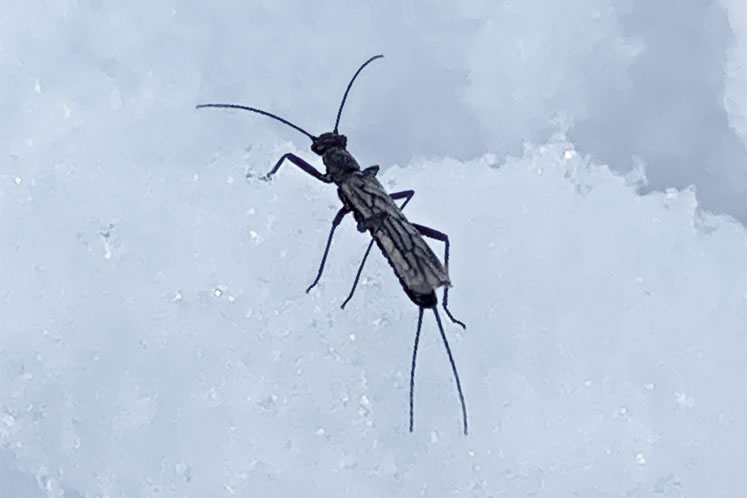
Eastern snowfly. Photo by Kim van Oosterom.
One of the nearly 2 million iNaturalist contributors is Kim van Oosterom, art director of this magazine. Kim admits to being a little obsessive, a trait that helped hook her on iNaturalist two years ago after she found her “gateway” bug, the whimsically named golden-backed snipe fly.
Since then Kim has submitted more than 300 observations, one of which caught the eye of an entomologist in Ottawa. This past January, Kim had an unexpected encounter with an insect crawling on the snow near her home in Mulmur. After posting its image on iNaturalist, she received an email from David Burton, a researcher at the Ottawa-based Canadian National Collection of Insects, Arachnids and Nematodes. Yes, there really is such an entity! Blown away by Kim’s discovery, David recognized it as a rare insect called an eastern snowfly. Kim was thrilled and happily stepped into a role as David’s temporary research assistant, gathering several snowflies and mailing them to him in Ottawa.
One remarkable feature of iNaturalist is its ability to automatically identify species. The organization’s computers have been “trained,” by looking at thousands of images, to render a prompt identification of plants and animals sent to them by smartphones. These IDs are usually correct, though the algorithms can be stumped by poor quality photos or particularly rare species. With many of us unable to distinguish a wasp from a bee or a spider from a deer tick, this feature in particular, and iNaturalist in general, offers a promising corrective to our collective eco-illiteracy.
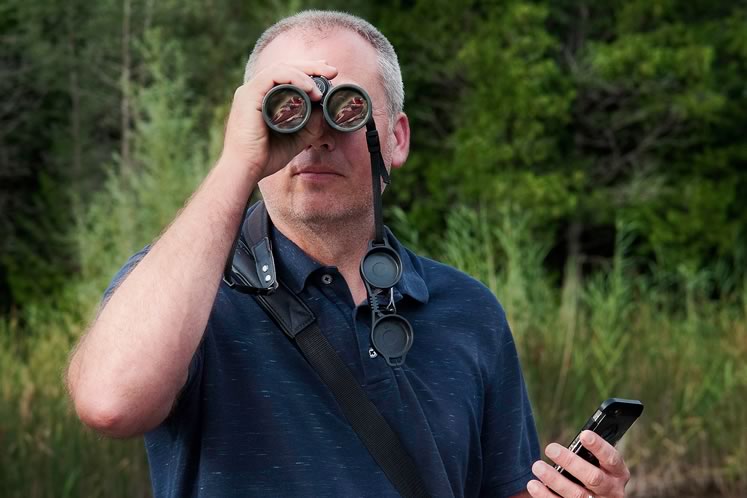
Conservationist Dan MacNeal observing cliff swallows in Amaranth. He has submitted more than 20,000 records to iNaturalist. Photo by Rosemary Hasner / Black Dog Creative Arts.
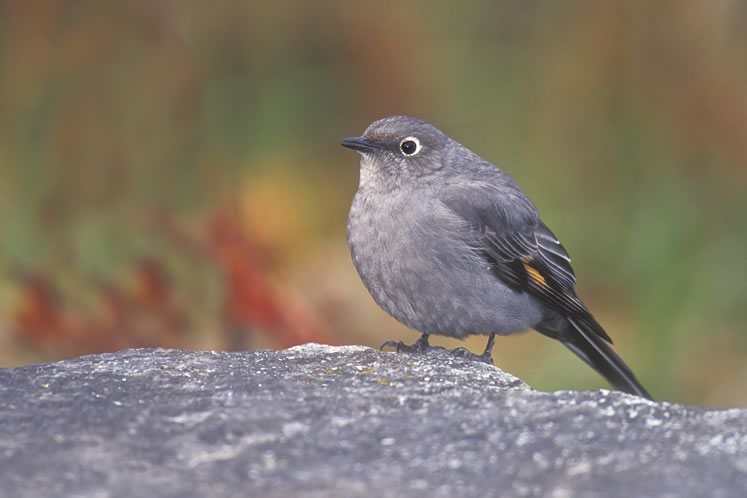
Townsend’s solitaire. Photo by Robert McCaw.
Showing the scope of the contributions a single citizen scientist can make to iNaturalist, Dan MacNeal has, to date, submitted more than 20,000 records. His facility with a smartphone is a wonder to behold. Sightings are photographed and submitted with one hand, with his binoculars primed in the other to find his next record. Because I am of a somewhat riper vintage than Dan, my approach is plodding in comparison. I fumble with my iPhone and prefer to take photos with my PowerShot camera, then download the images at home and send them to iNaturalist. This works for me.
More than half of Dan’s observations have been of moths. But his sightings of birds in the local countryside have sent ripples of envy through this region’s birding community. He has found several first-order rarities: birds thousands of kilometres from their usual home ranges, including a Townsend’s solitaire, a Say’s phoebe and a ruff that should have been home in Latvia or Siberia, not just west of Shelburne.
Maintaining that he isn’t an expert, Dan says “being able to contribute observations to science is probably the biggest appeal to me as well as the never-ending learning opportunities.” He views citizen science as extremely valuable. “Experts and researchers just can’t cover the area the public can. Literally anyone can participate and contribute valuable data.”
Dan is right. Smartphones, computer algorithms and a growing community of people who care about biodiversity make doing citizen science easy and fun.
Just ask Dan’s 11-year-old son, Desmond, who already has more than 3,400 iNaturalist observations to his credit. Or Taya Marsala, now eight years old and already an iNaturalist veteran and a valued Butterfly Blitzer. Last year Taya’s mom, Kristie Marsala, saw the Credit Valley Conservation program as a great way to escape Covid confines and get outside with her daughter. The rewards were immediate. “I like seeing all the butterflies and naming them,” says Taya. “I love to look at them close up with my mom!” A big find Taya made in 2020 was an Arctic skipper, uncommon in Headwaters but a lovely little butterfly with checkerboard-patterned wings.
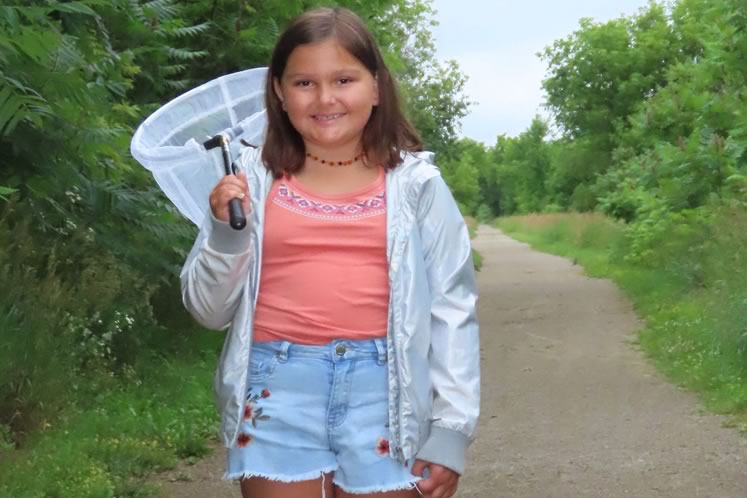
In 2020, young naturalist Taya Marsala spotted an Arctic skipper, rare in Headwaters. Photo by Rosemary Hasner / Black Dog Creative Arts.
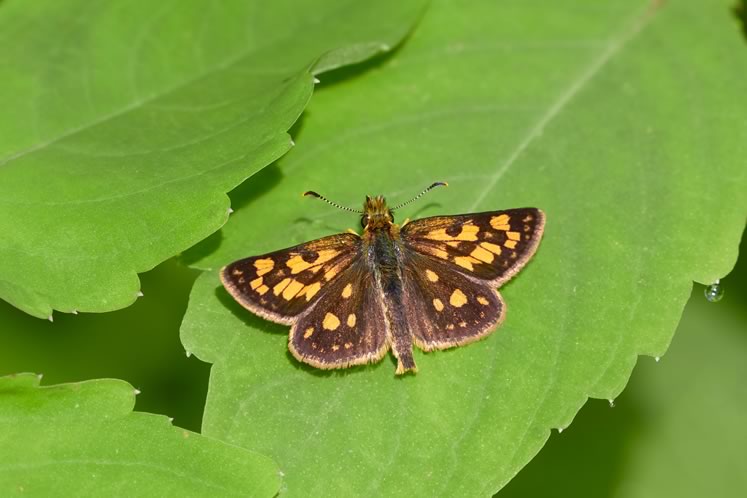
Arctic skipper. Photo by Robert McCaw.
This dynamic mother-daughter team practises catch and release. Butterflies are netted and then gently placed in a container for a close look and a photo shoot. And yes, Taya does name each one before releasing it. When I “blitzed” with them along the Elora Cataract Trailway one day in early July, Taya chose “Moonbeam” as the name for the single butterfly she found.
“Taya has learned the habitats, the life cycles and the markings on some butterflies,” says Kristie. “She can now call out butterflies as she sees them flying around us. After our hikes we feel rejuvenated and energized. The conversations we have are amazing. Seeing the butterflies through an eight-year-old’s eyes is enlightening and fascinating!”
Most of Kristie and Taya’s searches for butterflies take place close to their Erin home. This is another great feature of citizen science. There is abundant life just outside our doors and projects such as Butterfly Blitz and platforms such as iNaturalist encourage us to engage with it.
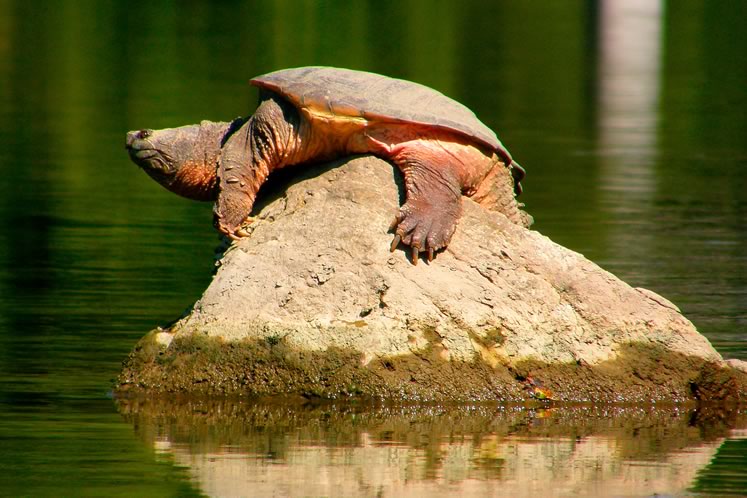
Snapping turtle. Photo by Don Scallen.
For 10 years, I counted turtles during kayaking adventures throughout southern Ontario and duly submitted thousands of observations to Turtle Tally, a citizen science project administered by the Toronto Zoo. My observations were subsequently shared with the Ontario Herpetofaunal Summary, a project administered from 2009 to 2019 by Ontario Nature and continuing now as the Ontario Reptile and Amphibian Atlas. I like to think my contributions – the result of hundreds of hours of surveying – will be of value for future conservation initiatives. I hope my efforts, as well as the tsunami of data flowing into iNaturalist and various other citizen science projects, have real conservation value.
Emma Horrigan, conservation projects and education manager at Ontario Nature, thinks it does. Emma has played a lead role in managing the Ontario Reptile and Amphibian Atlas, which uses the same survey squares as the Breeding Bird Atlas. The data collection phase is now over, and Ontario Nature staff, together with a volunteer publication committee of expert herpetologists, are hard at work creating an online atlas to show reptile and amphibian distribution across the province. Citizen scientists, however, continue to be encouraged to submit sightings to the “Herps of Ontario” project on iNaturalist – and to the Natural Heritage Information Centre if the species is at risk.
A citizen science approach “has been vital to the success of the ORAA project,” says Emma. “Herps are cryptic animals. They can be hard to find and the more eyes out there the better.” During the data collection phase, more than 12,000 pairs of eyes have helped the ORAA amass a remarkable 480,000 records. With 75 per cent of Ontario’s reptile species and 35 per cent of its amphibian species at risk, these sightings are invaluable. “Ontario Nature and other conservation organizations can now identify mortality hotspots along roads and prioritize areas for conservation action,” she adds.
In addition, at-risk Ontario herps enjoy varying measures of protection under federal and provincial statutes. The vast body of data collected by volunteers showing where these creatures live will prove crucial when development proposals arise.
Emma also lauds the educational benefits of conducting a project like the herp atlas. “We were able to reach thousands of volunteers and interested community members during the 10 years of Ontario Nature’s involvement with the project,” she says. “This outreach is important for building a greater understanding of and appreciation for this fascinating group of animals.”
Emma is now involved in the third Ontario Breeding Bird Atlas project which, at present, has more than 2,000 participants in the field collecting data on breeding birds throughout Ontario, though anyone can submit sightings to the atlas regardless of whether they have been assigned a particular square to cover.
The goal is to map the distribution and abundance of every species of breeding bird in Ontario. This, according to Emma, is “hugely important. The data gathered through this project will influence status assessments of birds in the province and will be essential for scientists and researchers involved in the conservation of birds. It will also inform policy planning by government officials.”
When the second Breeding Bird Atlas was completed in 2005, a comparison of the numbers recorded in the first atlas, completed in the early 1980s, detected an alarming decline in the population of birds, such as swallows, nighthawks and chimney swifts, that eat insects on the wing. These findings have spurred researchers to ask why and, unsurprisingly, a decline in the overall abundance of insects is implicated as one cause. The challenge now is to develop possible remedies, including stewardship actions landowners and municipalities could undertake to help these birds.
The Breeding Bird Atlas is a well-oiled data collection machine with a tried-and-true methodology. Priority is given to increasing the scientific literacy of contributors. Online seminars are hosted by ornithologists to help participants find birds, identify them properly, and determine breeding evidence. Survey protocols for cryptic bird species such as owls and other nocturnal birds are in place. And observations are vetted and approved by regional experts.
Lindsey Jennings and Laura Timms of Credit Valley Conservation manage the Butterfly Blitz project that has captured young Taya Marsala’s heart. Conducted in partnership with the Riverwood Conservancy, the project is now in year three of a five-year survey to document the distribution and abundance of species in the Credit River watershed. Last year Covid led to the cancellation of educational outreach and guided hikes, but data collection was still robust, and records increased over 2019.
Laura sees citizen science as satisfying two of CVC’s primary goals: connecting people to nature and collecting high quality data.
Butterflies are the focus obviously, but Laura knows that when people are tallying butterflies they inevitably “notice other things flying around and they notice plants and wonder what they are. People really start to engage in their neighbourhood and to go places they’ve never been before. It’s a really effective way of connecting people to nature.”
Kristie and Taya Marsala prove Laura’s point. As we strolled along the trailway on that July day, drizzle kept most of the butterflies at bay, but both of them found other things to capture their interest. Kristie wondered about the land snails taking advantage of the wet weather to cross the trail. Taya, meanwhile, was noticing little squiggly larval insects I had missed entirely.
To satisfy the goal of collecting high quality data, Butterfly Blitz requires that photos be taken of the butterflies, which are uploaded to iNaturalist and then verified by two butterfly experts. With confidence in the data, CVC is using it to fill gaps in butterfly coverage in the watershed. In one survey square near Orangeville, for example, only four butterfly species have previously been recorded – out of an expected species list of 60 or more.
At the close of the Butterfly Blitz project in 2023, Laura will “use the data for a conservation assessment of butterflies in the watershed. We’ll know then which species are locally rare.”
To ramp up interest in Butterfly Blitz, Lindsey Jennings, who specializes in community outreach, administered a kids’ colouring contest and a butterfly photo contest this past summer. Look for other community engagement activities from the program in 2022.
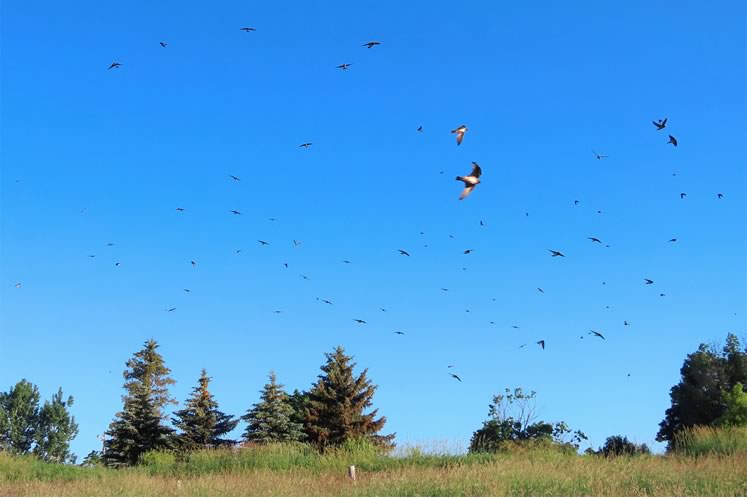
Cliff swallows. Photo by Don Scallen.
Citizen science expands our awareness of species at risk and their needs. Consider Mark Bell, a resident of Toronto’s Parkdale neighbourhood. Sitting on his balcony a few years ago, he noticed birds careening and twittering as they coursed through the evening air. They reminded him of bats.
Googling “bat-like birds,” he discovered that they were chimney swifts. Moreover, he found out that they are a threatened species being monitored through a citizen science program called SwiftWatch. Mark was stoked. He compared his discovery of swifts to finding out that whales might exist in Lake Ontario at the end of his street. He learned about these birds’ fantastic journey from the northern Amazon area to his Toronto neighbourhood – and decided to become a swift watcher.
Mark began evening walks around the city during swift breeding season, challenging himself to find their nesting and roosting sites by watching them “parachute” into chimneys at dusk. His proudest moment was the discovery of more than 200 swifts entering a chimney on an apartment building. He suffered angst when he subsequently found a metal cap on the flue of this chimney but was relieved when the swifts were able to relocate to an adjacent flue. For now, they are safe.
Mark’s swift-watching experiences have brought him closer to nature and kindled an awareness that considering the needs of other creatures must be built into our human-based decision making.
An oft-quoted statistic suggests American kids can recognize about 1,000 corporate logos but less than 10 species of plants native to their own area. There is no reason to expect Canadian children are much different. This speaks to a syndrome dubbed “nature deficit disorder.”
The surge in citizen science is helping us turn that deficit into a surplus. Children such as Desmond MacNeal and Taya Marsala, as well as countless adults, are learning about the wondrous diversity of nature and contributing valuable observations as they do. A synergy has been established between PhDs and laypeople. Everyone wins. Moms, dads and children are going outside, revelling in the joy of discovery, while scientists at universities are using their observations to write research papers. The smartphones that so often occupy our time as we sit in easy chairs have been repurposed to encourage activity and inquiry.
In the summer I met my friend Lorysa Cornish, an Orangeville resident and another Butterfly Blitzer and iNaturalist enthusiast, for a hike in the Upper Credit Conservation Area just outside Alton. We met at 10 a.m., rising pre-dawn is for the birds. Butterflies, though, are late risers like me. The sun beat down from a cloudless sky and the temperature was 28 C and rising. Perfect butterfly weather. We found many of our butterflies sipping moisture at a seep adjacent to the Credit River and Lorysa sent some great sightings to Butterfly Blitz, including a Compton tortoiseshell, a silver-spotted skipper and a Delaware skipper.
I asked Lorysa about her impressions of citizen science.
“Probably the greatest value it provides is by encouraging people – and I imagine children and preteens especially – to look at the world around them,” she said. “It’s a gateway to caring about nature and the planet. Raising awareness of our natural world and seeing how interesting it is will hopefully inspire future generations to appreciate the environment and take better care of it.”
I couldn’t agree more.
More Info
Citizen science opportunities mentioned in this article:
Credit Valley Conservation Butterfly Blitz
Ontario Breeding Bird Atlas Project
iNaturalist
Herps of Ontario a project within the iNaturalist app
SwiftWatch
Turtle Tally
A small sample of other citizen science opportunities:
Citizen Science Portal A great place to start is this government website that lists over 30 different projects and organizations throughout the country looking for volunteers to collect data: ic.gc.ca/eic/site/063.nsf/eng/h_97169.html
Birds Canada One of the organizations listed in the Citizen Science Portal, it offers 17 Citizen Science projects involving birds, including nocturnal owl surveys and the Canadian Lakes Loon Survey: birdscanada.org/you-can-help/citizen-science
NatureWatch Also hosted on the Citizen Science Portal are various NatureWatch programs including plantwatch, frogwatch, milkweedwatch, icewatch and – wait for it! – wormwatch: naturewatch.ca
Related Stories
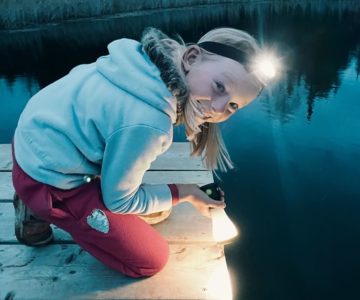
Wild Nocturne
Jun 22, 2021 | | EnvironmentGrab a flashlight and head out on a hike after sundown and get to know the creatures of the night – including moths, salamanders and frogs.
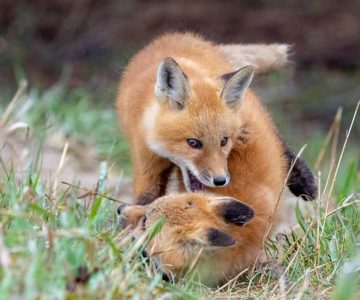
New Kits on the Block
Mar 31, 2021 | | EnvironmentRed foxes are making themselves at home in Inglewood, Grand Valley and Palgrave, hunting in our yards and denning under our sheds and garages.
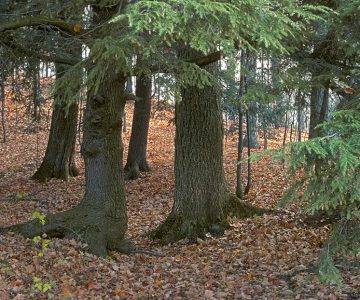
A Forest is More Than Its Trees
Sep 18, 2020 | | EnvironmentFrom deep in the earth to high in the sky, forests shelter teeming life.
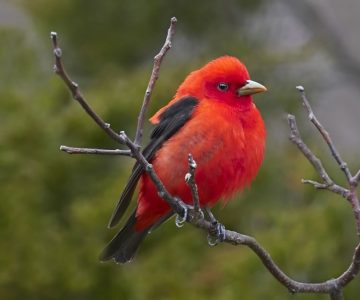
These Flora and Fauna Rely On Forests
Sep 18, 2020 | | EnvironmentHere are six plants and animals, representative of myriad others, that depend completely on forests.






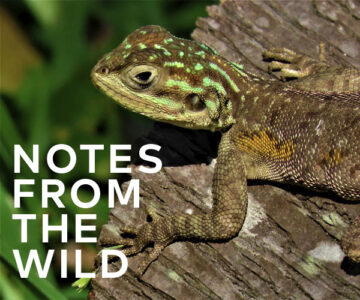







Spelled my name wrong at the end!
“I asked Lorsya about her impressions”. <– should be Lorysa
Lorysa Cornish on Sep 25, 2021 at 12:16 pm |
Hi Lorysa,
Fixed! And huge apologies for the typo. Many thanks from the In The Hills team for alerting us.
Tralee (associate editor)
Tralee Pearce on Sep 27, 2021 at 8:32 am |